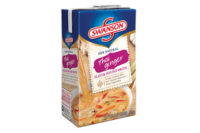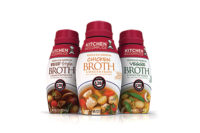2013 New Products Annual: Soups & Side Dishes
Changing Times in Soups and Sides
An examination of soups and sides introduced in 2012 finds a market expanding to include Millennials and a wider, more diverse palate.








Millennials—those between the ages of 18 to 34—now account for 25% of the U.S. population, according to Forbes, but what really matters is the amount of money this generation spends. Campbell Soup puts the group’s total spending power at $300 billion annually, enough to make any packaged goods company stand up and take notice.
Millennials are different from Baby Boomers. As a group, they tend look at food as a source of adventure and entertainment, and they are less likely than older consumers to see ethnic foods, like Indian or Asian, as exotic. Millennials grew up with ethnic foods and regard them as more routine than unusual or exotic.
This is the backdrop for the soup category, a market that booked a new product launch decline of 4.3% in 2012, says Datamonitor’s Product Launch Analytics database of new products. However, what the year lacked in raw numbers, it more than made up in aggressive new launches aimed at Millennial consumers and more.
Leading the charge was standard-bearer Campbell Soup, which is pinning future hopes on its new Go Soup line. Aimed squarely at Millennials, Go Soups are ethnic with unusual flavors, like Chicken Quinoa with Poblano Chilies and Moroccan Style Chicken with Chickpeas. Go Soup also is priced upscale, with suggested retails of around $2.99 per soup, nearly triple the going rate.
Go Soup signals a sea change in soup packaging. Gone are Andy Warhol’s favorite metal soup cans; Go Soup’s 14oz stand-up pouches are eye-catching and microwavable. The pouches even are equipped with “Cool Touch” thumbprint tabs that prevent burned fingers when handling the heated package.
Just to show that Go Soup was no “one-off,” Campbell also went upscale with new Gourmet Bisques, packaged in paperboard cartons. Golden Butternut Squash, Sweet Potato Tomatillo and Thai Tomato Coconut are three flavors offered, blending healthy vegetables and trendy flavors.
Butternut squash, in fact, has quietly become one of the hottest flavors in soup. In 2012, butternut squash surged to a tie for the 10th most popular soup flavor, up from a tie for 35th in 2011, per Product Launch Analytics. Hain Celestial’s Imagine Natural Creations Creamy Butternut Squash Soup, Sprouts Farmers Market Butternut Squash Soup and Target’s Archer Farms Simply Balanced Butternut Squash Ready to Serve Soup are just a sampling of 2012’s new butternut squash soup offerings, all coincidentally packaged in cartons—not cans.
Another flavor trend for soup in 2012 was hotter and spicier soups, reflecting broad interest in spicy foods. Campbell’s Chunky line was on-trend, with Chipotle Chicken & Corn Chowder, Jammin’ Jerk Chicken with Rice & Beans and Kickin’ Buffalo-Style Chicken Soup, the latter inspired by the popular Buffalo-style chicken wings. Thai-inspired soup flavors were also a flavor trend, illustrated by 365 Everyday Value Thai-Style Chicken Noodle Soup and Healthy Choice Thai Style Chicken with Brown Rice Microwaveable Soup.
A smattering of innovation in vegetable soups may help soup makers court meat-avoiding consumers. Go! Soup (from Coral Gables, Fla.-based Chefs Treats and no relation to Campbell Soup’s Go Soup) all-natural soup offers Asparagus Green Peas and Pumpkin Coriander refrigerated soups in microwaveable plastic cups. Campbell launched Harvest Orange Tomato Soup, a tomato soup made with orange tomatoes, an orange-colored variety of tomatoes known for their distinctive flavor. Time will tell, but this product could open the door to future introductions based on heirloom vegetables and specific vegetable varieties.
Surprisingly few soup makers are leveraging soup as a way to boost vegetable consumption. This approach is more typical in overseas markets like the UK, where New Covent Garden Soup Co.’s Great British Recipe Soup debuted in 2012 in flavors including Beetroot & Horseradish, which counts toward “1 of your five-a-day” fruits and vegetables.
Continuing the vegetable theme, New Covent launched Fresh Bowls Soup in the UK in 2012, a soup packaged in two-compartment plastic bowls that separate the liquid soup from fresh vegetables. The vegetables are steamed from the heat of the soup underneath when cooked; this is a novel way to boost the soup’s perceived freshness.
This focus on flavor and freshness was a nice change-of-pace for a category hurt by what proved to be an intense focus on health concerns surrounding sodium content. In fact, 2012 saw a drop in low-sodium soup introductions, with just 6.8% of soup launches making a low-sodium claim, per Datamonitor’s Product Launch Analytics. That was down by nearly half from the 12.9% of launches that claimed low- or reduced-sodium contents in 2011. Soups that did make sodium-reduction claims tended to be broth products, such as College Inn Beef Broth in a Fat Free & Lower Sodium variant. Gluten concerns were also back-burner in 2012, with just 6.8% of soup launches going gluten-free, down from 19% that did so in 2011.
One health claim on the upswing is low- or reduced-calories. Some 6.8% of 2012’s new soup launches made a low- or reduced-calorie claim, up from 3.5% in 2011. General Mills’ Progresso Light Soup went in this direction with indulgent flavors, including Chicken Pot Pie Style and Creamy Potato with Bacon & Cheese.
Soup marketers were busy introducing new packaging types in 2012. Chicken Soup for the Soul brand soup brings reusable glass Mason jars to the soup market, in traditional soup flavors—such as Chicken Noodle and Creamy Tomato. The search for a successful self-heating can continued in 2012, with Hot-Can Self Heating Soup from San Diego-based Hot-Can Inc. Pushing a button at the bottom of the plastic-sheathed can and shaking gently for 30 seconds produces hot soup just three minutes later. A temperature indicator on the can turns from black to green when the soup is heated.
Flexible pouches also are testing the self-heating concept. In Belgium, Heat It Hot Tomato Soup is packed in a 200ml self-heating pouch. Just press a button, and the contents of the pouch heat to 60 degrees Celsius (140 degrees F) in five minutes.
Side dishes may not appear to have much in common with soup, but this category also is feeling battered by the winds of change. According to Datamonitor’s Product Launch Analytics, launches of “dried ready meals” (a classification that includes side dishes) dipped 4.3% in 2012.
One headwind against the side dish category is the trend toward meal simplification. Simply put, consumers are making and eating meals that have fewer items. According to an NPD Group/National Eating Trends survey, Americans served 4.1 different food or beverage items at dinner in 2012, down from 5.3 items as recently as 1985. Lunch is in the same boat, with 3.3 items served in 2012 vs. 4.1 items in 1985. Simpler dinners and lunches threaten to boot side dishes to the curb.
The goal, then, is to introduce new side dish products compelling enough to earn a spot at the plate. In some cases, that means experimenting with unique flavors; in others, it means tapping convenience trends.
Side dish flavor innovation in 2012 included new ways to shake up old favorites. To some consumers, mashed potatoes are as pedestrian as it gets for a side dish, but not with the addition of applewood smoked bacon. That is what Idahoan Foods did with its Idahoan Applewood Smoked Bacon Flavored Mashed Potatoes. Cheese is another ingredient with “cravability” that goes well with potatoes. Asiago is a cheese variety not often seen in side dishes, but it is part of new Betty Crocker Parmesan & Asiago Potatoes.
Rice is another side dish recording significant flavor innovation in 2012. Brown rice and quinoa get together for Seeds of Change Moroccan Style Rice, while Osem USA’s new Side Mates All-Natural Family Side Dishes give an ancient grain a twist with its Quinoa with Rice, Black Beans & Corn variant.
This concept of combining ancient grains with conventional grains is something that took root in 2012. The Wegmans supermarket brand was a major innovator here, with Wegmans Food You Feel Good About 90 Second Steamables in a Seasoned Brown Rice & Quinoa variety that shows convenience and taste are not mutually exclusive. Wegmans Food You Feel Good About Rice & Grain Blend is even more exotic, using heirloom rice ingredients. The Aztec Blend flavor is described as a “medley of ancient grains, Coulusari heirloom red rice, whole-grain brown rice and multi-colored split peas.”
Pasta and noodles looked to Asia for flavor ideas, especially the street food concept, which is just beginning to impact packaged foods. Simply Asia Singapore Street Noodles pays homage to street foods with Kimchi and Sesame Ginger-flavored noodles. Also from Simply Asia Foods, Thai Kitchen Asian Creations Stir-Fry Rice Noodles feature a Purple Corn & Rice Noodles variety, purple corn being a first for noodles. Finally, Knorr’s Pasta Sides went Asian with Thai Sweet Chili, said to be made with real ginger for added spice and heat.
One trend which really did not catch fire in 2012 was the movement of vegetables into pasta. This is happening in main dish pastas, such as Mueller’s Hidden Veggie Spaghetti, which lists carrots, sweet corn and squash as ingredients. Ronzoni Garden Delight Pasta hints at the trend with a Trio Italiano variety boasting a half serving of vegetables from carrot, tomato and spinach. There could be more to come in 2013.
Another idea with untapped potential is the use of sprouted grains in side dishes. Main dish sprouted-rice products, like PlanetRice Sprouted Brown Rice, make a persuasive health case for the concept. PlanetRice says its sprouted rice is three times higher in GABA than regular brown rice.
Not to be left out, couscous continues to shine in side dishes, thanks to its ability to utilize almost any flavor. Among 2012’s flavor offerings were Garlic Jalapeno, Tuscan Herb and Porcini Mushroom flavors of Roland Israeli Couscous. Pearl couscous may be less common than “regular” couscous, but is also a focus of innovation. Osem USA’s Side Mates All-Natural Family Side Dishes Couscous line was launched in flavors like Portabella Mushroom & Sun-Dried Tomatoes and Tuscan Medley.
With side dishes running the risk of getting squeezed off the plate via meal simplification, one response has been to position traditional side dishes as main meal items. This was a rich vein of new product development in 2012, with important new launches, such as Healthy Choice Lunch Express Dried Ready Meal (rebranded from “Fresh Mixers”), Barilla All Natural Microwaveable Meal, Progresso Kitchen Favorites Entrée Mix, and even Betty Crocker Mac and Cheese (a new challenger to Kraft Mac and Cheese with liquid cheese sauce, not powder).
Of the three “main dish” launches, Barilla’s Microwaveable Meal may be the most novel, featuring what Barilla calls “revolutionary packaging.” Barilla separates the pasta from pourable sauce (packed in a separate cup) to maintain the taste, texture and freshness of the pasta. The shelf-stable pasta microwaves in 60 seconds for a quick meal in “authentic Italian” flavors, such as Mezze Penne alla Marinara.
This concept of ingredient separation to enhance freshness is an area where side dish makers seem to be paying more attention. In Spain, Monbolet Risotto Mix recently debuted in a kit-type box holding two sachets—one with the base ingredients (mushroom and rice) and the second containing dried onion and broth.
Side dish options outside of the center store are also proliferating and present challenges to center-store, dry side dish brands that may be perceived as “freshness-challenged.” Hormel Country Crock Simple Ideas Cheddar Broccoli Rice Refrigerated Side Dish is fully cooked. And, in the freezer case, one can find Betty Crocker Loaded Smashed Potatoes (from Nonpareil Farms) and Green Giant Seasoned Steamers Backyard Grilled Potatoes. Both offer quick microwave preparation.
Looking for a reprint of this article?
From high-res PDFs to custom plaques, order your copy today!









